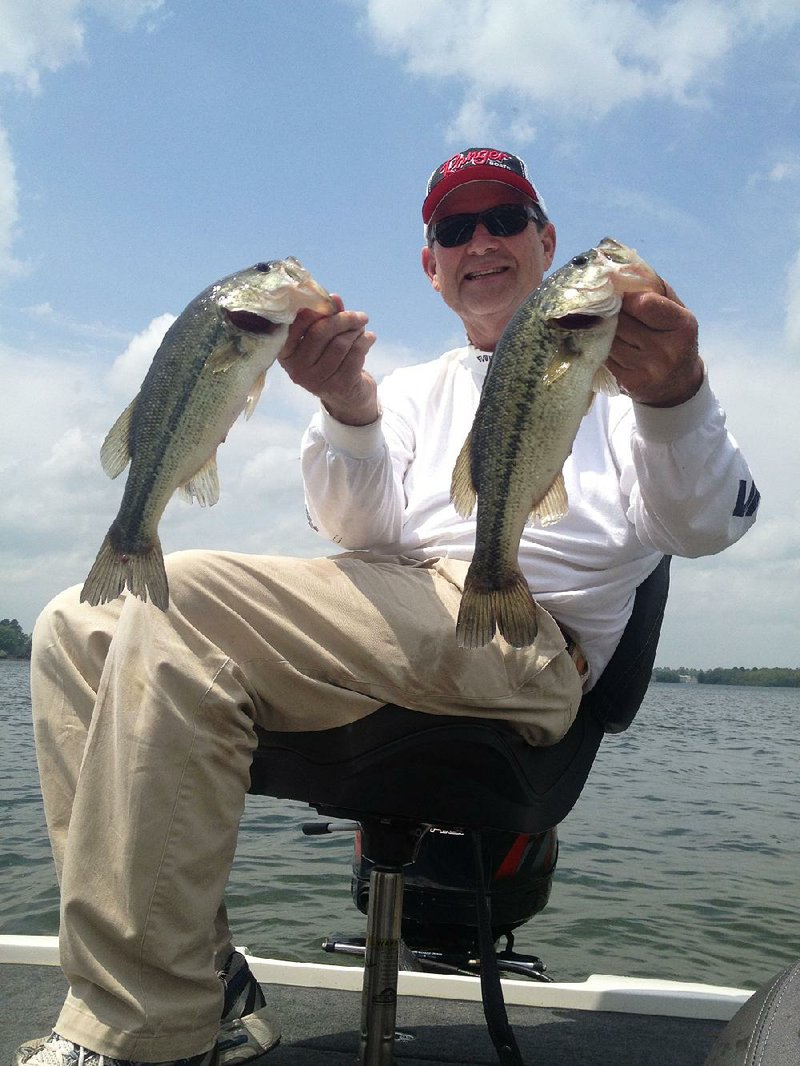LAKE HAMILTON - I was only 15 minutes late, but George Cochran already had four keeper bass in the live well when I arrived at the ramp.
Cochran, a two-time Bassmaster Classic champion and 2005 Forrest Wood Cup champion, made a small fortune catching and releasing bass as a professional angler. Now that he’s retired, they support him in a different way.
He eats them, with great enthusiasm.
“I can smell the grease heating up already,” Cochran said as I boarded his immaculate Ranger Comanche bass boat. “While I was waiting for you, I just went around the corner and caught almost half a limit. The conditions are just right to make them bite all day.”
Lake Hamilton, probably the busiest recreational lake in Arkansas, is under rated for bass fishing, Cochran said. That’s understandable since Lake Ouachita, the first of three Ouachita River impoundments, is just a few miles upstream. Lake Hamilton is a lot smaller and is better known for summer water parties, but it produces some excellent bass fishing of its own, especially in the springtime.
“It’s so easy, too,” Cochran said. “I know it’s hard to find fish here in the hot summertime, but you can fish nothing but docks right now and catch them all day long.”
Impounded in 1932, Lake Hamilton has virtually no natural fish habitat anymore, but an endless array of boat docks provides unlimited cover. Bass like docks because they are shady and offer cover from which to ambush bait fish. Also, bass spawn in the shallow water behind the docks, so they relate to these artificial structures in all phases of their spawning cycle.
Consequently, Lake Hamilton fishes like a miniature version of Lake of the Ozarks, a renowned Missouri fishery that, like Hamilton, is owned and managed by an electric company.
Some docks are better than others, though.
“I like to fish docks that are on points,” Cochran explained. “They’re closer to deep water than the ones back in the coves, and we know that bass relate to points.”
Cove docks can be good, too, he added, if a boat lane has been excavated into the slip.
Fishing docks is simple, Cochran said. When you approach a dock, fish the inside and outside corners and then fish the length of the dock, starting from the inside corner to the outside corner. As you pass the dock, skip a bait inside the boat slips, or between floats. As you pass the dock, fish the corners on the other side and then fish the length of the dock. Also, fish the shallow water between the dock and the shore. That final option was very productive for us because a lot of fish were guarding nests in those sheltered zones.
Cochran and I used just two baits the entire day. We used plastic worms rigged “wacky” style. To rig a wacky worm, you simply run a small drop-shot hook through the worm’s swollen middle - or egg sac - and leave the point exposed. We also used the same worm on a 1/16-ounce jig head, or shaky head. This makes the worm fall faster, and because the hook point is buried inside the worm, it is nearly snagless. The only color we used was red pumpkin.
“A little later, they like brighter colors, junebug, tequila sunrise and things like that,” Cochran said.
For tackle, we used spinning rigs and 6-pound test line. They were sufficient since our biggest bass was only 17 inches long, and even a small bass fights like Muhammad Ali on light tackle.
My first cast was a wacky worm to the outside edge of a dock. A small bass smacked it, and it only got better. We caught fish from the first couple of docks we hit, but then we hit a dry spell. Cochran had better luck with the shaky head, so I switched to it as well.
“When we pull up to these docks, notice which way the wind is blowing,” Cochran said. “They like to face into the wind because it blows bait to them.”
Cochran had better luck catching bass inside the boat stalls, but I caught most of mine on the inside corners and between the dock and the bank. My sloppy casting prevented me from hitting tight spots. I kept after it, though, and I was hitting teacup size targets.
“You’re getting better as we go along, and I’m getting tired and falling apart,” Cochran said.
“That’s why we’d make a good four-ball team,” I said. “You carried us on the front nine. I’ll carry us on the back nine.”
The fish bit in spurts. We caught two or three from one dock and none from the next two or three. Then we hit another hot dock, followed by a couple more dead docks. It went like that until we quit at noon with 14 keeper largemouth and spotted bass in the live well.
“I can smell the grease getting hot,” said Cochran afterward as he powered up his electric filleting knife at the Andrew Hulsey Fish Hatchery boat ramp cleaning table.
They were beautiful filets, firm and white. Fried in cornmeal, they tasted as good as they looked.
Sports, Pages 34 on 04/21/2013

